|
|
|
| Preface
I received a gracious offer from a member of the Felder Owners Group to write a review of his newly purchased Felder KF700eco. Since the owner was within driving distance and I was quite curious about the Felder we arranged for a Saturday to visit and go over the machine. The owner did not purchase the "commissioning package" therefore the machine was basically in the "as-delivered" state when I saw it. |
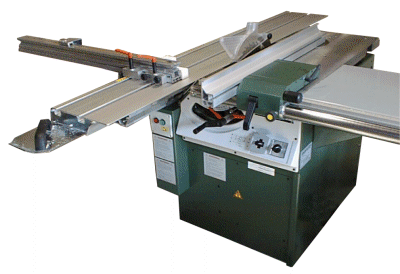 |
Impressions In comparing my own Hammer B3 to this machine, it
becomes obvious after only a brief inspection that the construction of the Felder is
measurably more substantial in several areas. |
|
| Table Saw The saw is basically similar to several other Euro machines of this type. It has a riving knife that travels in the same plane as the blade, soft start, blade brake, and a dust hood that attaches to the riving knife. This machine was not equipped with the scoring blade however. My general impression of the noise made by the saw is that it was at least as loud as my Hammer B3; one would definitely want to wear hearing protection when operating the saw. The blade spools up to speed in a couple of seconds and seems quite stable. None of the very limited testing we did taxed the saw for power but it appeared to be capable of delivering all one would reasonably ask of it. In testing, we were using a Felder Silent Power 12" rip blade. While I didn't find it particularly silent at all, it did give a very good cut. Good enough in fact, that it could probably be left on as the "normal" blade. When measured, flange run-out was essentially zero. I was curious to see if the Felder has the same (hard to describe) "loose" effect when the blade angle is transitioned through 22.5 degrees that my Hammer has. Unfortunately, the blade bevel mechanism was very difficult to move so I could not find out. It appears that there was some defect in the mechanism as the blade raise was about 10 times easier to use. Because of this defect, I did not have the opportunity to observe how well the controls really worked. |
| I was quite keen to closely inspect the rip fence
on the machine. Due to my own previous bad experience with the rip fence on my B3, I had
low expectations for the Felder. The rip fence rail is a solid round bar attached to the
iron table. The "head" captures this bar nearly completely and as a result of
the design, it has basically no slop when loose, this keeps it parallel when moved.
Because of this design however the fence cannot be lifted off, it must be slid off the end
to get it out of the way. The fence itself is remarkably similar in profile to the Unifence, it has the same high-low configuration and can be slid back and forth as desired. While I didn't measure it, the stiffness seemed to be about the same as a Unifence. Unlike a Unifence, the Felder is equipped with a micro adjust system. While any decent fence can be adjusted fairly precisely this micro adjust system I think is the jewel of this design, it is one of the smoothest operating ones I've used. I did not test the operation to see how parallel it remained but it operated very smoothly. |
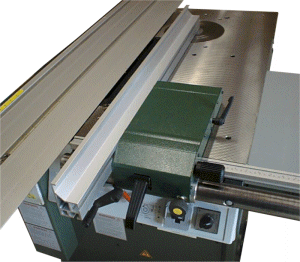 |
| The only glaring omission in the design
of the fence is that it does not utilize a cursor, one must sight down the face of the
fence to set to the desired width. The deficiency is all the more evident since it would
be so easy to have used a cursor. Overall, American rip fence designs like the Biesemeyer
and Unifence are technically superior however the Felder fence system is (to my surprise)
actually good enough that (unlike the Hammer) it could be kept on the machine. The owner
does have some additional issues with the design due to his desire to use a power feeder
with the machine. While this can be addressed it isn't without the use of additional
user-made jigs. There have been some issues raised about the Felder fence and its inability to be locked down at certain points along the rail where the rail attachment bolts are. I neglected to investigate this myself. The owner has subsequently reported no problems in this regard. |
|
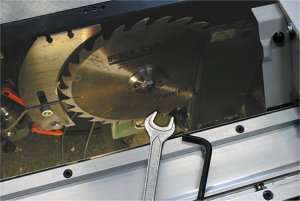 |
The power switch for the saw is stationed at the
front corner of the machine. This is not a particularly user-friendly position however
it's my contention that this is par for the coarse on ANY format type sliding table saw.
There really just isn't any good position for the switch on the chassis that in some way
isn't going to be blocked by the sliding table or something else. The only REAL solution
to this is to have the switch above the table like on an over-arm blade guard. Again, I
think this is an issue common to ALL Euro sliding table saws. |
| Dust collection for the saw appears to be at the same level as my Hammer. Basically it doesn't get it all since the blade shroud isn't very big. It does however get well over 90% of it; it may not look like that when the cabinet is opened up but in my own testing of my B3 I know this to be true. Access to the blade for changes is quite good and better than the typical cabinet saw. | |
| Shaper The Felder shaper uses a unique interchangeable spindle design. This means that it is relatively easy to use whichever size spindle you want including a high-speed router variant. I was most interested in how "easy" it would be to change out spindles since it appears many owners get a normal shaper spindle and the high speed router spindle as well. When measured, spindle run-out was essentially zero. Unlike my Hammer, the internal shaper controls are accessed via the side of the machine (the slider is moved to access them) instead of through a door in the aft end. As a result, I believe the Felder controls can be accessed a little easier. The actual raise and tilt controls are in the normal positions one would expect. Curiously, the shaper tilt control on this machine exhibited the same "binding" movement that the saw blade angle adjustment did. There was no obvious adjustment to free this up so I'm again assuming that this is a factory defect. |
 |
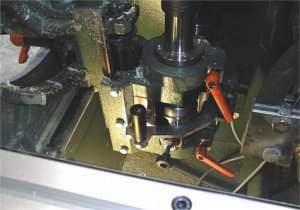 |
To change spindle speeds the belt must be repositioned, pretty standard for a shaper. A tension lever is provided which makes for easy operation of the feature. To change the spindle itself, two levers and a knob are released (along with belt tension). The only thing that introduces any difficulty in this operation is that there isn't a lot of free play in the belt so it may get hung up a bit. The key (apparently) is to move the belt to the largest pulley first then extract the spindle. A user who has done this a few times would probably make this process look pretty seamless. Overall, spindle changes are fairly easy and a nice beneficial feature of the machine - if you can afford separate spindles. |
| The power switch for the shaper is
located on the side of the machine and includes a light to indicate direction. To select
the shaper and the rotation direction the switch on the front of the machine must be
accessed. In testing the shaper we made full depth cuts in pine using a raised panel cutter. I don't normally make this heavy a cut but wanted to see if the machine was capable of delivering the power to do so. Basically it did but I could not tell there was any difference between this 4hp motor and my own 3hp B3. The shaper fence is a
pretty massive affair, I cannot imagine any reasonable tooling that it could not
accommodate. All the controls worked well. The owner had purchased the "safety
bar" accessory and "micro-adjust" device to go with the shaper. The micro
adjust device moves the entire fence in or out referenced from a couple of pin holes in
the iron table. Without it, only the outfeed fence face is adjustable in and out. |
|
| Sliding Table The sliding table on a Felder is probably the jewel of the entire system. On the whole it appears very sturdy and moves which an exceptional "controlled swoosh" feel to it. The table wagon is about 12" wide and has two large T-slots running it's length. The Felder slider is a bit different from others in that it uses roller bearings instead of ball bearings. I think this and the overall heft of the system makes for a more controlled feel to the action. It does however increase to the effort required to move the table. In general I believe the Felder slider may be more accurate than the more common Hammer design but I also believe one would be hard pressed to measure that difference. |
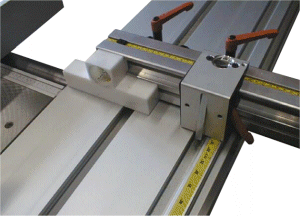 |
| This particular table was very well
adjusted from the factory regarding parallelism to the blade. The height had been adjusted
by the owner to be more even to the plane of the iron table. In order to do this the saw
switch need to be removed to get to the height adjustment bolts. My impression is that the
height adjustment and ability to maintain the table level to a plane to be equal to the
Hammer slider and probably most others as well. The crosscut fence on this machine was fitted solely to the sliding table, the owner did not purchase the outrigger for his machine. Compared to the Hammer, this fence is probably about 4 times stronger, it is definitely a super-heavy-duty design. The fence includes a stop block with a magnified cursor and an adjustable tape measure. Like the Hammer the crosscut fence can be very easily and quickly removed and replaced without any loss in accuracy. This is VERY important on sliding table saws. |
|
| Summary The Felder KF700eco is certainly a very nice machine by any standard one would care to use. It is sturdily built and has several cleverly designed features unique to the Felder line. The primary high points of the machine are:
The primary low points of the machine are:
I would like to express my thanks to Imran Malik for his hospitality and providing me this opportunity to review his machine. He can be reached via Email should the reader care to pose any specific questions regarding his machine. |